Solar Impulse waits out weather before take-off for Hawaii
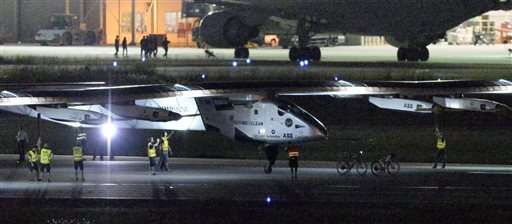
Ultimately when it comes to adventure, however advanced the technology, the weather holds the trump card.
A solar-powered plane attempting to circle the globe without a drop of fuel was sitting in Japan on Tuesday waiting out unexpectedly bad weather after making an unplanned landing.
Swiss pilot André Borschberg took off from Nanjing, China, on Sunday—Saturday in Asian time zones—on what was to be the longest leg of the journey, a six-day, 8,175-kilometer (5,079-mile) flight to Hawaii.
But he had to land in Japan, and Bertrand Piccard, initiator, chairman and co-pilot of Solar Impulse 2, told the organizer's live feed, Solar Impulse TV, that the plane will continue its journey to Hawaii when the weather improves.
The team achieved its goal of the longest flight ever of a solar plane going through the night, he said.
"It's just the weather doesn't fit. Everything we could do has been done and was successful. What we cannot control is the weather. So we land in Nagoya, we wait for better conditions, and we continue," Piccard said.
The journey started in March in Abu Dhabi, and the plane has stopped in Oman, India, Myanmar and China. The flight from Nanjing to Hawaii is the seventh of 12 flights and the riskiest since there is no place to land, so the pilot will likely wait a few days for the weather to change.
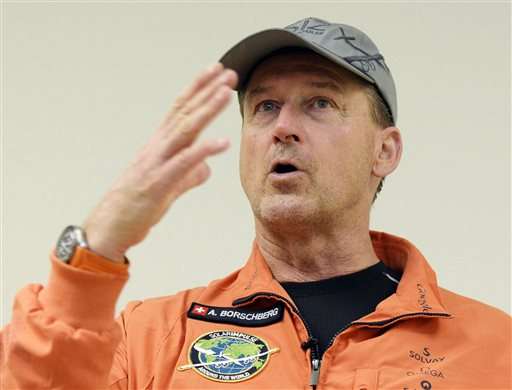
After more than 40 continuous hours of flying, the Solar Impulse 2 landed late Monday at the Komaki airport in Nagoya, central Japan. Normally, the 1,700 kilometer (1,050 mile) trip would take less than three hours. But traveling at only 100 kilometers (62 miles) an hour, it takes much longer.
Borschberg spent about seven hours waiting to land, but the rest of the time was spent traveling from China. At the time he began his descent, his batteries were fully charged—illustrating the aircraft's ability to generate power while using it.
But at the time of landing, the plane's batteries were 74 percent charged, reflecting the extra energy required for landing.
Weather and nights pose special challenges for a solar-powered plane, said Claudia Durgnat, a spokeswoman for the Solar Impulse project.
A detour around a cloud consumes extra energy, but more importantly, the aircraft is not designed to withstand extreme weather.
"It does not take water or turbulence," Durgnat said.
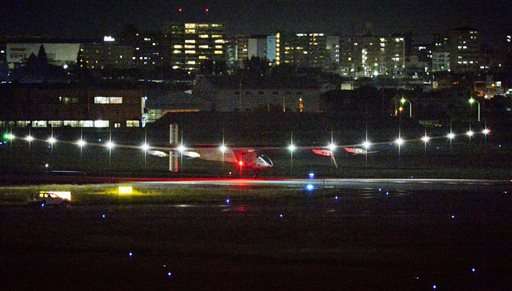
At night, the aircraft must descend from its usual altitude of up to 8,200 meters (23,000-24,000 feet) to 1,000-3,000 meters (3,300-9,850 feet) to reduce power consumption from the pilot's oxygen mask.
In the morning, the pilot needs to have enough power left over to ascend to his daytime altitude.
"That is why this is a big challenge," Durgnat said. "All of the calculation the pilot must do to make sure he doesn't find himself without energy if it's not well managed."
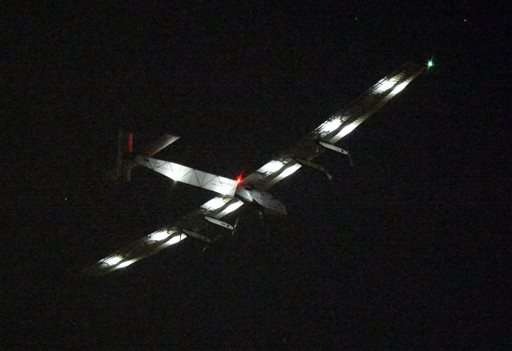
Japanese Transport Ministry and Nagoya airport officials arranged for Solar Impulse to land after the airport's usual closing hours to accommodate the plane with a wide wingspan.
-
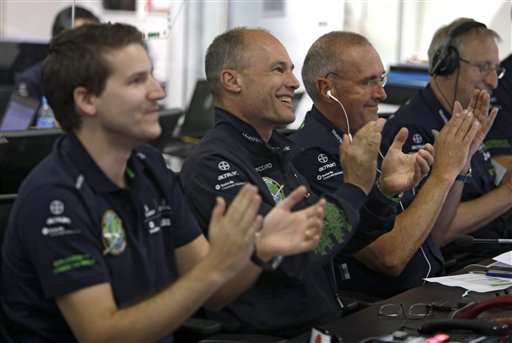
Bertrand Piccard, Initiator and Chairman of Solar Impulse, center, reacts with Mission Director Raymond Clerc, right, and son of Swiss pilot Andre Borschberg piloting Solar Impulse 2, Deniz Borschberg, left, after the landing of Solar Impulse plane in Nagoya, Japan, at the Mission Control Center for the Solar Impulse flight in Monaco, Monday, June 1, 2015. The Swiss solar-powered plane Solar Impulse 2, is attempting to fly around the world without a drop of fuel, but now plans to make an unscheduled stop Monday night in Nagoya, Japan, because of bad weather on the way to Hawaii. (AP Photo/Lionel Cironneau) -
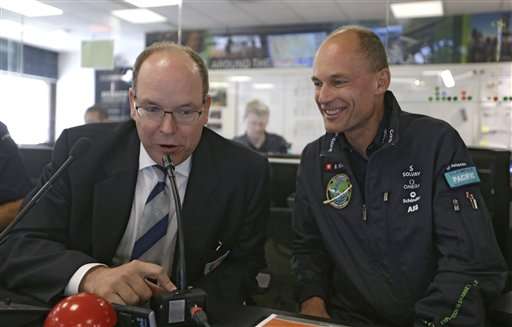
Bertrand Piccard, Initiator and Chairman of Solar Impulse, right, with Prince Albert II of Monaco speak with Swiss pilot Andre Borschberg piloting Solar Impulse above Japan, at the Mission Control Center for the Solar Impulse flight in Monaco, Monday, June 1, 2015. The Swiss solar-powered plane Solar Impulse 2, is attempting to fly around the world without a drop of fuel, but now plans to make an unscheduled stop Monday night in Nagoya, Japan, because of bad weather on the way to Hawaii. (AP Photo/Lionel Cironneau)
© 2015 The Associated Press. All rights reserved.





















